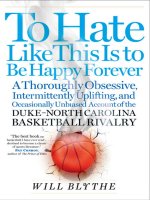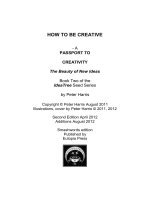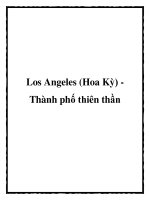I never liked to be called a los angeles artist
Bạn đang xem bản rút gọn của tài liệu. Xem và tải ngay bản đầy đủ của tài liệu tại đây (19.42 KB, 2 trang )
ART
“I never liked to be called a Los Angeles artist.” Meet conceptual artist John Baldessari, who many
describe as a cultural symbol and the grandmaster of the Los Angeles art scene. “My perception of the
city is very ugly. But that’s attractive too. It’s very seductive.”
In this interview John Baldessari reflects upon his long artistic career, his beginning and cultural
influences, and why in the 1960’s he gave up painting for mixing the narrative potential of photographic
images with the associative power of language.
Just before his 85th birthday, Baldessari here defends the cultural and social importance of art. “It seems
to be a nutritional need for the public. We build museums, people go there with their kids. The bad thing is
the connection with money now. They look at a Rembrandt and ask how much it costs. We are looking at
art with the wrong eyes and values.”
John Anthony Baldessari (b. 1931) is an American conceptual artist, who lives and works in Santa Monica
and Venice, California. In his career stretching over six decades he has been exhibited in more than 200
solo shows. His works are part of major public and private collections, including the Museum of Modern
Art, the Guggenheim Museum and the Los Angeles County Museum of Art. His work is said to have
influenced a number of internationally renowned artists such as Cindy Sherman, Catherine Opie, Barbara
Kruger and Tony Oursler.
John Baldessari was interviewed by Marc-Christoph Wagner in his studio in Venice, Los Angeles in
January 2016.
2.Every painting is always two paintings: The one you see, and the one you remember." Interview with the
renowned writer Siri Hustvedt on her strong personal relationship with art and on how she sees image
and text as very different experiences.
In this interview American writer Siri Hustvedt (b.1955) explains how the experience of art is always a
deeply personal one, which we keep with us as a memory, like meeting a person: "The work of art we
carry around with us is a memory, not like the original." Since we're always changing, always becoming, it
is possible to return to a piece of art years later and have a completely new experience, and in this way
Hustvedt has rediscovered art more than once: "Either because I failed to notice something, or because I
wasn't in a position to notice."
Hustvedt explains how she attempts to make a kind of translation of her experience of a work of art into
an essay, but how "the word is always an abstraction, in a way that looking at an image is not." Hustvedt
also talks about curiosity, sensitivity, over stimulation, Goya, and having to sometimes look away. Art is
supposed to affect us and alter us, she says: "I'm never interested in what I can easily understand."
Siri Hustvedt has written poetry, novels, essays, and a work of non-fiction. Her books include What I
Loved (2003), The Sorrows of an American (2008) and The Shaking Woman or A History of My Nerves
(2010).
The essay "Why Goya?", that Siri Hustvedt is reading in the film, is from her collection of essays: "Living,
Thinking, Looking" published in 2012.
Siri Hustvedt was interviewed by Synne Rifberg at the Louisiana Museum of Modern Art in Humlebæk,
May 2013.









